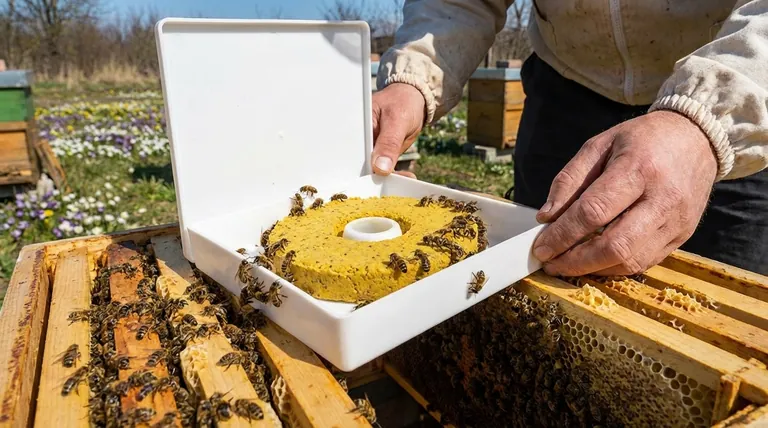At its core, a pollen patty is a man-made protein supplement for honey bees. Its purpose is to stimulate the queen to begin laying eggs and raising young bees, known as brood, before natural pollen sources become available. This gives the colony a significant head start on building its population for the spring.
The central strategy behind using pollen patties is to intentionally create a population boom within the hive. This ensures a massive workforce is ready to forage the moment the main spring nectar flow begins, but this intervention carries the critical risk of expanding too early.

The Role of Pollen in the Hive
Pollen as the Engine of Growth
Pollen is the sole source of protein, lipids, and vitamins for a honey bee colony. While honey provides carbohydrates for energy, pollen is the essential building block for raising new bees.
Without an incoming source of protein, the queen will not, and cannot, begin the process of building the colony's population.
The Queen's Signal to Lay
The availability of pollen directly triggers the queen's egg-laying rate. As nurse bees consume pollen, they produce royal jelly, which is fed to the queen and the young larvae.
A surplus of pollen signals to the entire colony that it has the resources necessary to feed and raise a new generation of bees.
Aligning with the Natural Cycle
In nature, the first tree blooms of spring provide the pollen that kicks off this cycle. The pollen patty is simply an artificial version of this natural trigger, allowing a beekeeper to start the process weeks earlier.
Why Intervene with Pollen Patties?
Creating a Stronger Foraging Force
The primary goal of early feeding is to ensure the hive's population peaks at the exact same time as the main nectar flow in your area.
A larger population of forager bees translates directly into a larger honey harvest or more effective pollination of crops.
Timing is the Decisive Factor
Beekeepers typically provide pollen patties in late winter or very early spring. The goal is to time the feeding so the new generation of bees emerges just as the weather becomes consistently warm and flowers begin to bloom.
Understanding the Critical Trade-offs
The Risk of Expanding Too Soon
The most significant danger of using pollen patties is stimulating brood rearing too early in the season. This creates a large population of vulnerable young that require constant warmth.
The "Chilled Brood" Problem
If you stimulate a population boom and a late cold snap occurs, the cluster of adult bees may be too small to cover all of the new brood.
Any brood left uncovered will get cold and die, a condition known as chilled brood. This event can severely set back the colony's development and weaken the hive.
Increased Resource Consumption
A rapidly growing colony consumes its stored honey and syrup at a much faster rate. Feeding pollen without also ensuring the hive has ample carbohydrate stores can lead to starvation.
Making the Right Decision for Your Hive
Using a pollen patty is a calculated decision that depends entirely on your goals and local climate.
- If your primary focus is maximizing early honey production: Strategically timed pollen patties can create the powerful foraging force needed to take full advantage of the first nectar flow.
- If your primary focus is colony survival with minimal risk: Allowing the hive to build up naturally based on local flower availability is the safer path, completely avoiding the danger of chilled brood.
Ultimately, using a pollen patty is a tool to align your hive's growth with your specific beekeeping objectives.
Summary Table:
| Purpose | Benefit | Key Consideration |
|---|---|---|
| Stimulate Brood Rearing | Creates a larger foraging force for spring nectar flow | Risk of chilled brood if a cold snap occurs |
| Provide Protein Supplement | Essential for queen egg-laying and young bee development | Colony will consume stored honey faster; ensure ample food |
| Align Hive Growth with Goals | Maximizes honey production or supports natural survival | Timing is critical and depends on local climate and objectives |
Ready to build a stronger, more productive apiary?
Strategic feeding is key to maximizing your honey yield. At HONESTBEE, we supply commercial apiaries and beekeeping equipment distributors with the high-quality supplies needed for success. Our wholesale-focused operations ensure you get the reliable pollen patties and feeding equipment required to support your colony's growth effectively and safely.
Let's discuss your beekeeping goals. Contact our team today to get the right supplies for your operation.
Visual Guide

Related Products
- HONESTBEE Professional Hive Top Bee Feeder Feeding Solution
- HONESTBEE Professional Entrance Bee Feeder Hive Nutrition Solution
- Boardman Entrance Bee Feeder Durable Galvanized Steel and Wood Construction for Beekeeping
- Professional Hive Front Entrance Bee Feeder
- Professional Galvanized Hive Strap with Secure Locking Buckle for Beekeeping
People Also Ask
- What safety features are included in top feeders? A Guide to Drowning Prevention and Hive Safety
- How do I keep bees from drowning in my top feeder? Ensure Safe Feeding for Your Hive
- What are the advantages of hive top feeders? Maximize Feeding Efficiency for Your Apiary
- What is a top feeder for bees? Maximize Colony Health with Efficient Feeding
- What is the best way to top feed bees? A Safe, High-Volume Feeding Solution for Your Apiary



















